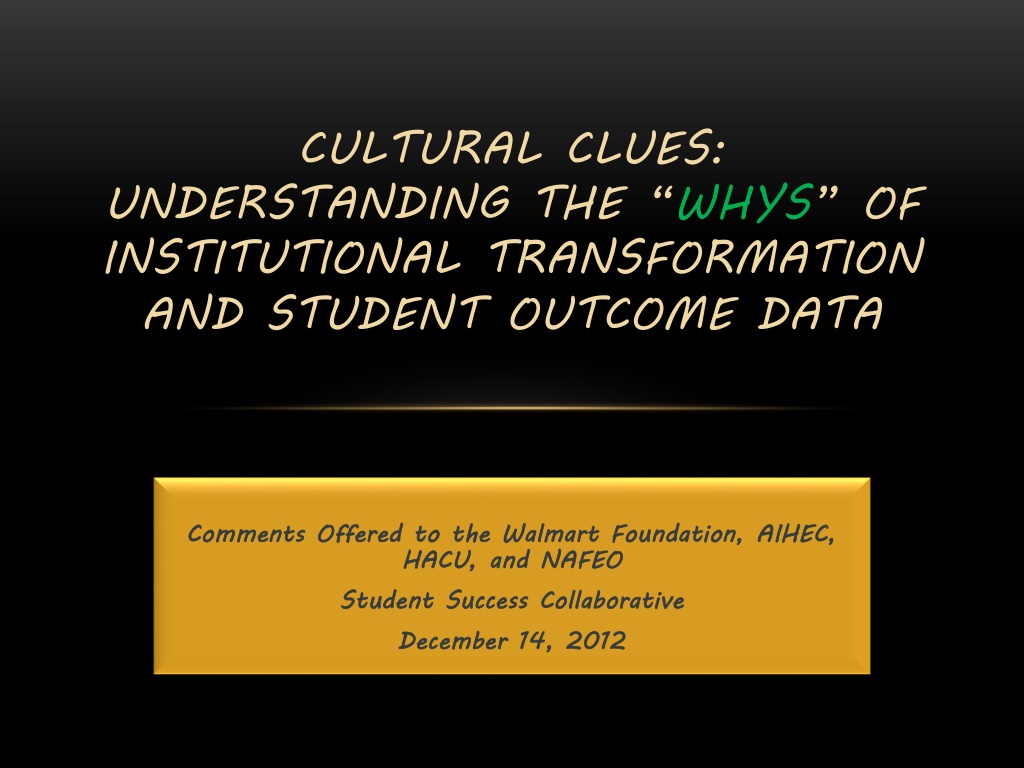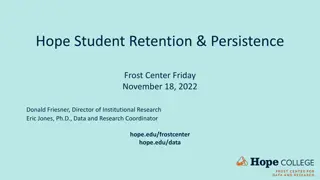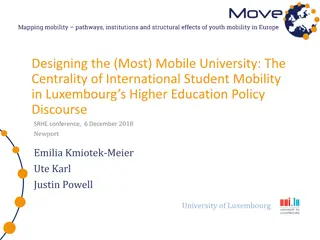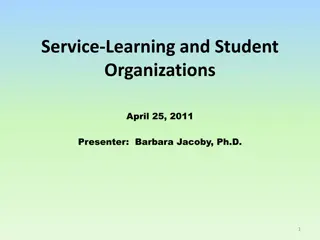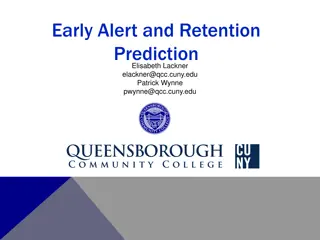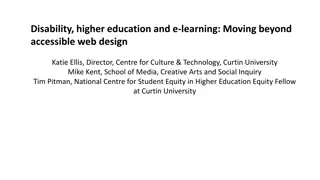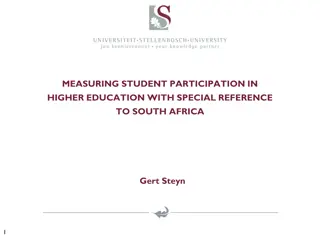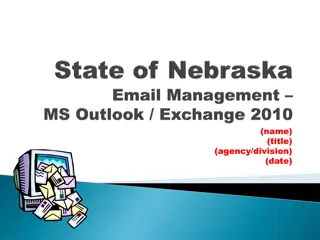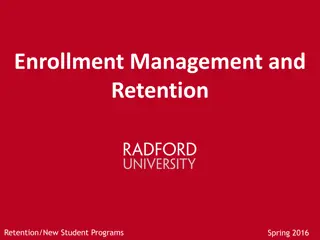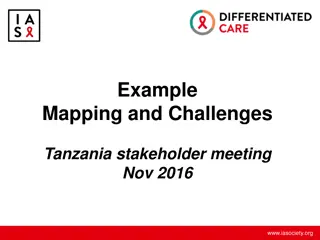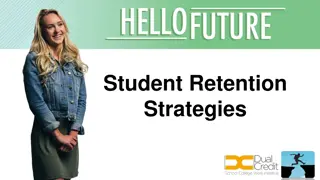Understanding Factors Influencing Student Retention in Higher Education
This presentation delves into the challenges of understanding the factors that truly impact student retention in higher education. It highlights the importance of moving beyond data collection to gaining insights into why outcomes occur, rather than just what they are. Dr. Melvin E. Hall emphasizes the need for effective program evaluation to generate evidence that informs decision-making and enhances student success.
Download Presentation

Please find below an Image/Link to download the presentation.
The content on the website is provided AS IS for your information and personal use only. It may not be sold, licensed, or shared on other websites without obtaining consent from the author. Download presentation by click this link. If you encounter any issues during the download, it is possible that the publisher has removed the file from their server.
E N D
Presentation Transcript
CULTURAL CLUES: UNDERSTANDING THE WHYS OF INSTITUTIONAL TRANSFORMATION AND STUDENT OUTCOME DATA Comments Offered to the Walmart Foundation, AIHEC, HACU, and NAFEO Student Success Collaborative December 14, 2012 Comments Offered to the Walmart Foundation, AIHEC, HACU, and NAFEO Student Success Collaborative December 14, 2012
GREETINGS! There are so many reasons I am pleased to be here, please indulge me a bit of personal history 1967 off to UIUC 1968 Project 300 500 1971 C.H.A.N.C.E. 1979 Doctorate in Measurement and Evaluation 1984 2002 Leadership positions in higher education 2000 Director of State and Partnership GEAR UP Grants {$20,000,000 & kids from 12 communities Summer Enrichment Program Peer Mentoring Programs 2002 2005 Programs for access and opportunity 2000 s RCEI; 2012 CREA 2009 Developmental Perspectives on Human Diversity A few ironies: Many students who fit your special missions will naively feel that they do not and may even be intimidated by historical missions because ethnic identities are so contested today Evidence and accountability favor the status quo and always will because definitions must seek common denominators unless you create and validate your own {Be the lion s historians!} Not all data is evidence; evidence is data with a purpose! (Y. Lincoln) MELVIN E. HALL, PROFESSOR DEPARTMENT OF EDUCATIONAL PSYCHOLOGY NORTHERN ARIZONA UNIVERSITY
LOCATING THIS CONVERSATION My Worldview - comes from what you have just heard My vantage point - on this topic was shaped by that and my external relationship to this project I have few specifics or concrete predispositions My voice - interested and invested bystander with cogent experiences MELVIN E. HALL, PROFESSOR DEPARTMENT OF EDUCATIONAL PSYCHOLOGY NORTHERN ARIZONA UNIVERSITY
STARTING POINT In our evidence driven higher education culture extensive data collected; some of it qualifies as evidence decision-making, most does not. We have many tools that provide indicators the outcomes look as they do. data is evidence useful and influential in indicators of what our outcomes are, yet few that explain why How can we gain a better understanding of the factors that really affect student retention? Can program evaluation lead to more data that qualifies as evidence? This presentation will focus on the questions for which we need better answers find them. answers, and the resources and strategies that may help us MELVIN E. HALL, PROFESSOR DEPARTMENT OF EDUCATIONAL PSYCHOLOGY NORTHERN ARIZONA UNIVERSITY 4
PROBLEMS I SEE WITH THE CURRENT APPROACH Using Operational Definitions That Do Not Fit The Experience Because They: Are too general or distant from the interventions Are not linked to a theory of change Are not timely or persuasive Use a unit of analysis that does not match the intervention MELVIN E. HALL, PROFESSOR DEPARTMENT OF EDUCATIONAL PSYCHOLOGY NORTHERN ARIZONA UNIVERSITY 5
TYPICALLY OUR GOALS INCLUDE: Institutional Review and/or transformation to support student success Adding to the general understanding of strategies that work for particular populations and at particular types of institutions Improving practice and reducing barriers Taking students where they are, rather than selecting only those with an incoming success profile Adding value, even when ultimate goals are not met MELVIN E. HALL, PROFESSOR DEPARTMENT OF EDUCATIONAL PSYCHOLOGY NORTHERN ARIZONA UNIVERSITY 6
A SIMPLE DATA CONCEPTUALIZATION SCHEME College Level Data Needs Data that speaks to accountability and meeting campus goals College Level Data Needs An Overall Data Collection, Self- Study, and Program Evaluation Plan PowerPoint has new layouts that give you more ways to present your words, images and media. Intervention Level Data Needs Data that monitors contextual factors Intervention Level Data Needs Data That Explores Outcomes Individual level data, because that is where retention occurs Data That Explores Outcomes MELVIN E. HALL, PROFESSOR DEPARTMENT OF EDUCATIONAL PSYCHOLOGY NORTHERN ARIZONA UNIVERSITY 7
REMEMBER THOSE OLD FILE CABINETS? Thinking Evaluatively MELVIN E. HALL, PROFESSOR DEPARTMENT OF EDUCATIONAL PSYCHOLOGY NORTHERN ARIZONA UNIVERSITY
A SIMPLE DATA CONCEPTUALIZATION SCHEME Detailed Test Scores, Attendance & Compliance Data Cohort-Based Retention Data Cohort-Based Comparisons Survey Data on Concurrent Events Selected Longitudinal Case Studies This folder might include data in a cohort structure so that each group could be analyzed separately and combined with other groups Cohorts could be formed based upon any clear criteria for example each year a new cohort could be formed if the key question was changes in how the groups were treated and the related results; or by other characteristics that might be meaningful as a unit of analysis i.e. returning or older students, STEM and non-STEM students, etc. Data that goes into the folder could include memos, pictures, newsletter articles, counselor notes, program event flyers, etc MELVIN E. HALL, PROFESSOR DEPARTMENT OF EDUCATIONAL PSYCHOLOGY NORTHERN ARIZONA UNIVERSITY 9
A SIMPLE DATA CONCEPTUALIZATION SCHEME Detailed Test Scores, Attendance & Compliance Data Cohort-Based Retention Data Cohort-Based Comparisons Survey Data on Concurrent Events Selected Longitudinal Case Studies This folder might include data comparing students in a special program to students who are under general admissions It would be important to anticipate the most useful scheme for selection comparison groups, and this should be guided by a theory about what factors relate to retention, and avoid the use of categories or labels that are not linked to actual retention decisions such as race, gender, etc. The comparisons should promote or examine retention strategies actually being used, so that it collects data on effectiveness Other organizing schemes could include financial aide portfolios, or admissions criteria MELVIN E. HALL, PROFESSOR DEPARTMENT OF EDUCATIONAL PSYCHOLOGY NORTHERN ARIZONA UNIVERSITY 10
A SIMPLE DATA CONCEPTUALIZATION SCHEME Detailed Test Scores, Attendance & Compliance Data Cohort-Based Retention Data Cohort-Based Comparisons Survey Data on Concurrent Events Selected Longitudinal Case Studies This folder might include interview and survey data for all students at the institution so that concurrent events can be factored into the retention equation. UMCP for example found that some past cohorts of students had such a negative experience they were much less likely to donate money or support the school in other ways. Issues that impact all students should be factored into retention analysis and examined for differential impact on the targeted retention groups. This may be thought of a as a baseline calculator to allow analysis to appropriately acknowledge factors that may influence ultimate retention numbers. MELVIN E. HALL, PROFESSOR DEPARTMENT OF EDUCATIONAL PSYCHOLOGY NORTHERN ARIZONA UNIVERSITY 11
A SIMPLE DATA CONCEPTUALIZATION SCHEME Detailed Test Scores, Attendance & Compliance Data Cohort-Based Retention Data Cohort-Based Comparisons Survey Data on Concurrent Events Selected Longitudinal Case Studies This folder provides qualitative data to help with interpretation of the quantitative data collected elsewhere. Case studies would be great, but can be time consuming so notes from survival skills classes might prove useful. Theme assignments from English classes could be used to track trends and issues of interest. Progressive assignments (completed in serial fashion and stored a student portfolio i.e. task stream or equivalent) Another option here would be virtual discussions or collaborate sessions The goal might include better documentation of some of the distal event and environmental factors influencing student success Perhaps Mindset & Skill Profile Data could be included MELVIN E. HALL, PROFESSOR DEPARTMENT OF EDUCATIONAL PSYCHOLOGY NORTHERN ARIZONA UNIVERSITY 12
A SIMPLE DATA CONCEPTUALIZATION SCHEME Detailed Test Scores, Attendance & Compliance Data Cohort-Based Retention Data Cohort-Based Comparisons Survey Data on Concurrent Events Selected Longitudinal Case Studies This folder could include comprehensive quantitative and demographic data accumulated throughout application, admissions, and retention efforts. The profiles created would provide a way to select peers for benchmarking and goals for performance periods Note that these data will often import values and priorities that may not be compatible with intervention program values. This folder is the place to note gaps in philosophy and potential problems of analysis they cause. For example, a program may be student success oriented and count transfers to other colleges as a success even though the student has not been retained at the initial institution of enrollment, other programs would not. MELVIN E. HALL, PROFESSOR DEPARTMENT OF EDUCATIONAL PSYCHOLOGY NORTHERN ARIZONA UNIVERSITY 13
DATA ON INSTITUTIONAL CHANGES AND OVERALL RETENTION SUCCESS What grounds your institutions philosophy regarding student retention? Is the goal to only recruit students that can be successful; take students from wherever they stand academically and support them becoming credentialed graduates; serve a public, tribal, or community mandate; or come combination of the above? What tracking data could provide evidence of the extent to which the institutions policies and practices support the philosophy or mission statement? Where does the retention process fall in institutional priorities and what supports that ranking? Is it driven by external or internal sanctions? Can you follow the money and find retention where you would expect it in institutional priorities? MELVIN E. HALL, PROFESSOR DEPARTMENT OF EDUCATIONAL PSYCHOLOGY NORTHERN ARIZONA UNIVERSITY 14
DATA ON THE REAL WORLD OF YOUR STUDENTS Since College is never the only thing going on in a students life: What information do you collect to help with understanding the other important factors? Is there a version of the Beloit College Mindset list for the students you serve? The Mindset List for the Class of 2016 They should keep their eyes open for Justin Bieber or Dakota Fanning at freshman orientation. They have always lived in cyberspace, addicted to a new generation of electronic narcotics. Michael Jackson s family, not the Kennedys, constitutes American Royalty. If they miss The Daily Show, they can always get their news on YouTube. Bill Clinton is a senior statesman of whose presidency they have little knowledge. Exposed bra straps have always been a fashion statement, not a wardrobe malfunction to be corrected quietly by well-meaning friends. They have lived in an era of instant stardom and self-proclaimed celebrities, famous for being famous. http://www.beloit.edu/mindset/ MELVIN E. HALL, PROFESSOR DEPARTMENT OF EDUCATIONAL PSYCHOLOGY NORTHERN ARIZONA UNIVERSITY 15
INDIVIDUAL STUDENTS ARE THE MOST VALID OF ANALYSIS IN RETENTION STUDIES THAT IS THE LEVEL WHERE DECISIONS ARE MADE HOW WELL DO WE UNDERSTAND THEIR DECISIONS? MOST VALID UNIT MELVIN E. HALL, PROFESSOR DEPARTMENT OF EDUCATIONAL PSYCHOLOGY NORTHERN ARIZONA UNIVERSITY 16
DEFINING SUCCESS ONE ONE STUDENT AT A TIME MELVIN E. HALL, PROFESSOR DEPARTMENT OF EDUCATIONAL PSYCHOLOGY NORTHERN ARIZONA UNIVERSITY 17
A USEFUL IMAGE Concurrent Events Contextual Proximal Distal Events Immediate Outcomes Stable Outcomes Long term Changes Factor Events Planned Intervention MELVIN E. HALL, PROFESSOR DEPARTMENT OF EDUCATIONAL PSYCHOLOGY NORTHERN ARIZONA UNIVERSITY 18
A USEFUL IMAGE Institutional characteristics Non-Academic Responsibilities Concurrent Events Culture & Environmental Life Shaping Experiences Academic Preparation & Exposure Academic Graduation Retention Progress Employment Context (Mindset) When students go through your program, why are some successful and others not? To be evidence, data must relate to the questions of interest. Planned Intervention Study Advising Groups MELVIN E. HALL, PROFESSOR DEPARTMENT OF EDUCATIONAL PSYCHOLOGY NORTHERN ARIZONA UNIVERSITY 19
HOW MUCH DATA DO YOU COLLECT ON CONCURRENT EVENTS & ISSUES STUDENTS ARE FACING? Institutional characteristics Non-Academic Responsibilities Non-Academic Responsibilities Concurrent Events These events are possible threats to student success, to what degree can you document what they are with data and build coping resources into your retention initiative? {?} Planned Intervention Study Advising Groups MELVIN E. HALL, PROFESSOR DEPARTMENT OF EDUCATIONAL PSYCHOLOGY NORTHERN ARIZONA UNIVERSITY 20
EMERGING CONCEPTS TO FACTOR INTO RETENTION STRATEGIES Many of the popular retention initiatives focus on making the institution more responsive, the advising more intrusive, and the instruction more tailored What dominates the worldview of the students you seek to retain, and what tools do we have to better understand their worldview and its consequences? Self-Theories, Stereotype Threat, & Attribution Style Student Engagement Factors - Social Myopia & Hyperopia MELVIN E. HALL, PROFESSOR DEPARTMENT OF EDUCATIONAL PSYCHOLOGY NORTHERN ARIZONA UNIVERSITY 21
TOOLS THAT HELP DECIPHER THE ORIGIN AND MAINTENANCE OF KEY ATTITUDES Entity theory, here the belief is that human attributes are fixed entities that are not subject to personal development. Incremental theory, here the belief is that human attributes can develop and change incrementally through a person s efforts. Just imagine how an idea like meritocracy interacts with these implicit theories MELVIN E. HALL, PROFESSOR NORTHERN ARIZONA UNIVERSITY FOR PRESENTATION ONLY DO NOT CITE OR DISTRIBUTE
A FIXED VERSUS CHANGEABLE VIEW OF ABILITIES Fixed View Changeable View What I have is it, and I must protect my self-image My talents and abilities are maleable and responsive to my efforts MELVIN E. HALL, PROFESSOR DEPARTMENT OF EDUCATIONAL PSYCHOLOGY NORTHERN ARIZONA UNIVERSITY 23
IMPORTANT DEVELOPMENTAL PERSPECTIVES This is important as a foundation for understanding student decision making, by first understanding their perceptions and what impact them Differences and similarities in human characteristics reflect opposite sides of the same coin; without similarities differences would have no meaning, and vice versa. MELVIN E. HALL, PROFESSOR NORTHERN ARIZONA UNIVERSITY FOR PRESENTATION ONLY DO NOT CITE OR DISTRIBUTE
Self-Identity As Trivial Pursuit It is useful to use images such as the game Trivial Pursuit to make self-identity formation and maintenance concrete Picture illustrates collection of identity components as pie shapes MELVIN E. HALL, PROFESSOR NORTHERN ARIZONA UNIVERSITY FOR PRESENTATION ONLY DO NOT CITE OR DISTRIBUTE
MELVIN E. HALL, PROFESSOR NORTHERN ARIZONA UNIVERSITY FOR PRESENTATION ONLY DO NOT CITE OR DISTRIBUTE
EQUITY BELIEFS OBSERVED IN STUDENTS Conservative ProgressiveRacism, sexism, US society Colorblind Issues of equity reflect overblown and exaggerated claims, providing cover for poor personal choices US is now a race transcendent nation; future improvements in equity require race neutral policies & classism continue largely unchecked In MELVIN E. HALL, PROFESSOR NORTHERN ARIZONA UNIVERSITY FOR PRESENTATION ONLY DO NOT CITE OR DISTRIBUTE
VIEW POINT = LENS (A DISPOSITION) MELVIN E. HALL, PROFESSOR NORTHERN ARIZONA UNIVERSITY FOR PRESENTATION ONLY DO NOT CITE OR DISTRIBUTE
VIEWPOINT ILLUSTRATION In journal responses students often report reactions to articles that I have assigned. The articles build on the notion of self-identity and report revelations authors had developed through reflecting on their own histories and self- identity components. I receive comments like I remember this article hitting home for me. I am a white female who grew up in a poverty type of situation similar to the author Robin DiAngelo. These intersections are important opportunities for building understanding MELVIN E. HALL, PROFESSOR NORTHERN ARIZONA UNIVERSITY FOR PRESENTATION ONLY DO NOT CITE OR DISTRIBUTE
VIEWPOINT ILLUSTRATION Because of this common link (self-identity and the worldview it supported) students were sometimes moved fairly dramatically to examine the impact of their own backgrounds. Like the individual who responded to an author s discussion of internalized attitudes: I have to admit [an attitude of racial dominance] is also internalized inside of me. Having to discuss this is me having to be truly open to admit that I was raised with White is a better race to be a part of. Internalized racism and sexism is carried uneasily by many of our students MELVIN E. HALL, PROFESSOR NORTHERN ARIZONA UNIVERSITY FOR PRESENTATION ONLY DO NOT CITE OR DISTRIBUTE
VIEWPOINT ILLUSTRATION Understanding the difficult intersections of race and class is also facilitated through looking back. Students would recall that Even though I was poor and poverty held a stigma, I was still living in a middle class neighborhood full of White people. This linkage was reported by students even when they were unable to accept the additive effect of these forces in their current lives. MELVIN E. HALL, PROFESSOR NORTHERN ARIZONA UNIVERSITY FOR PRESENTATION ONLY DO NOT CITE OR DISTRIBUTE
VIEWPOINT ILLUSTRATION Some of the very revealing comments I have received alerted me to the degree to which people can separate and segment their thoughts on equity issues. Often what remains of a situation where equity was an issue, is the impact the individual felt for themselves with no real expressed understanding or empathy for what happened to others or any broader impacts. For example, the student who first recalled encountering racism when she wanted to date a man of a different race, noted that I saw a side of my mom I had never seen before. Still to this day I remember her reactions. She put fear inside of me and I minded her wishes. I laid down to her racism not to mine. I am not proud but in order for me to grow from this silent oppression I have held onto for many years I must be open to it. MELVIN E. HALL, PROFESSOR NORTHERN ARIZONA UNIVERSITY FOR PRESENTATION ONLY DO NOT CITE OR DISTRIBUTE
VIEWPOINT DISCUSSION Viewpoint is resistant to change: new material has to be integrated, accommodated, altered, or rejected some things literally cannot be seen Getting students (or anyone) to see that their viewpoint is not the only one is easy; getting them to see that theirs is not the norm is much harder. As humans we even re-write our history to better justify the place we now stand and the attitudes we hold MELVIN E. HALL, PROFESSOR NORTHERN ARIZONA UNIVERSITY FOR PRESENTATION ONLY DO NOT CITE OR DISTRIBUTE
MOVING STUDENTS TO A PLACE OF VIEWING THEIR OWN IDENTITY TIED TO THAT OF OTHERS IS AN AMBITIOUS BUT WORTHY GOAL MELVIN E. HALL, PROFESSOR DEPARTMENT OF EDUCATIONAL PSYCHOLOGY NORTHERN ARIZONA UNIVERSITY 34
melvin.hall@nau.edu MELVIN E. HALL, PROFESSOR DEPARTMENT OF EDUCATIONAL PSYCHOLOGY NORTHERN ARIZONA UNIVERSITY
